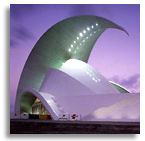Books |
Santiago Calatrava: Complete Works
By
Published: Jan 01, 2005
Category:
Art and Photography
Four years after 9/11, no one could decide on the buildings that would replace the World Trade Center or the memorial that will be erected to honor the dead. Then Calatrava was hired. He went wildly over budget. But he made something fantastic. White as bone, arched like a fish and ornamented with white steel that looks like fish bones radiating from a spine, it’s like nothing Americans have ever seen. There’s a reason: The architect of the first building to be erected on this iconic American site isn’t an American.
Santiago Calatrava is a Spaniard who has worked extensively in Zurich and Paris and Barcelona. He has won a million prizes and 13 honorary doctorates. And he is generally considered the planet’s most exciting architect.
Why the praise? Because Calatrava’s work is like no other: a skyscraper that twists and turns like a plant growing toward the sun, an apartment building that looks like randomly stacked cubes. He draws, he sculpts, he takes his cue from nature.
The work that made Calatrava’s reputation are bridges, which suggest great modernist wings. Or strings of a giant harp. One thing they don’t look like: bridges. That bold declaration of independence from tradition makes you gape — you’ll read this book with your jaw slack. [To buy ‘Santago Calatrava: Complete Works’ from Amazon.com, click here.]
It’s a beautiful volume, the most exciting art book I’ve seen in a long time. Five and a half pounds. Three hundred images. Connections that will excite anyone who cares not just about architecture and engineering, but about sculpture and anatomy and poetry.
Calatrava, though hardly obscure, is not someone you’ll read about in InStyle or see on Barbara Walters’ list of the year’s most important people. He’s a serious artist who works on a vast public scale in ways that delight people who know nothing about architecture — or, as yet, about him. That will change. But for right now, there is no coffee-table book that more emphatically declares that you — or your lucky recipient — is a person of great good taste.


